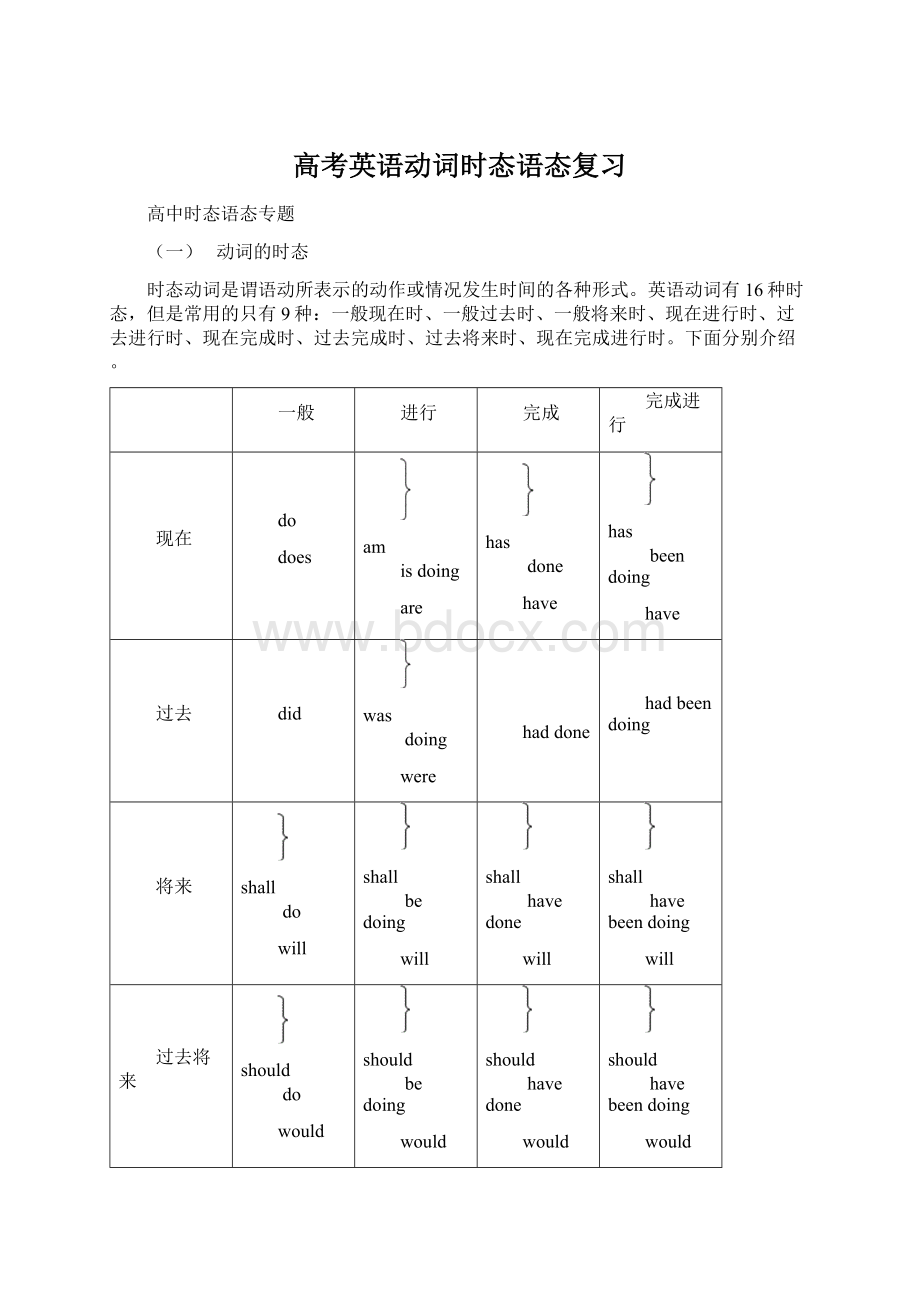高考英语动词时态语态复习.docx
《高考英语动词时态语态复习.docx》由会员分享,可在线阅读,更多相关《高考英语动词时态语态复习.docx(14页珍藏版)》请在冰豆网上搜索。

高考英语动词时态语态复习
高中时态语态专题
(一) 动词的时态
时态动词是谓语动所表示的动作或情况发生时间的各种形式。
英语动词有16种时态,但是常用的只有9种:
一般现在时、一般过去时、一般将来时、现在进行时、过去进行时、现在完成时、过去完成时、过去将来时、现在完成进行时。
下面分别介绍。
一般
进行
完成
完成进行
现在
do
does
am
isdoing
are
has
done
have
has
beendoing
have
过去
did
was
doing
were
haddone
hadbeendoing
将来
shall
do
will
shall
bedoing
will
shall
havedone
will
shall
havebeendoing
will
过去将来
should
do
would
should
bedoing
would
should
havedone
would
should
havebeendoing
would
考点一、一般现在时:
一般现在时表示主语经常性和习惯性发生的动作或存在的状态。
1、常用的时间状语有:
always(总是;一直),often(经常),sometimes(有时),seldom(很少),hardlyever(几乎不),never(从不),everyday(每天),everyweek(每星期),everymonth(每月),everyyear(每年)等。
2.第三人称单数的构成方式
当主语是第三人称单数时,谓语动词要用第三人称单数,其变化规则同名词变复数。
(1)直接在词尾加�s。
swim→swims,travel→travels,play→plays,leave→leaves
(2)以字母s,x,ch,sh,o结尾的,在词尾加�es。
pass→passes,fix→fixes,teach→teaches,wash→washes,go→goes,do→does
(3)以“辅音字母+y”结尾的,变y为i加�es。
study→studies,fly→flies,cry→cries
例、Diana,togetherwithherfriends,__________ChineseinChina.
A.study B.havestudiedC.studiesD.arestudying
3.一般现在时的用法小结
(1)表示经常性或习惯性发生的动作或存在的状态,常与表频度的时间状语连用。
Mymotheroftendoeshousework.Myfathergoestoworkeveryday.
(2)描述现在的状态、能力、性格等。
Sheisverytirednow.HespeaksRussianverywell.
(3)描述客观真理、客观存在或科学事实等。
Thelighttravelsfasterthanthesound.Thesunrisesintheeast.
注意、
(1)在宾语从句中,即使主句是一般过去时,但从句表示客观真理、客观存在或科学事实时,从句依然用一般现在时。
Theteachertoldusthattheearthisroundyesterday.
(2)在时间、条件状语从句中,用一般现在时表示将来。
即“主将从现”。
IwanttobeapolicemanwhenIgrowupinthefuture.
I'llringyouupifhecomesbacktomorrow.
(3)在以here,there开头的句子中常用一般现在时代替现在进行时。
Herecomesthebus!
汽车来了!
Theregoesthebell!
铃响了!
(4)一般现在时常出现在格言或警句中。
AllroadsleadtoRome.Oneisnevertoooldtolearn.
考点二、一般过去时:
表示过去某个时间所发生的动作或存在的状态。
1、常用的时间状语有:
yesterday(昨天),thedaybeforeyesterday(前天),lastweek(上星期),lastmonth(上个月),lastyear(去年),threeyearsago(三年前),in2001(在2001年),theotherday(前几天),justnow(刚才),等。
2.动词过去式的构成方式
在一般过去时中,谓语动词要用过去式,过去式的变化分为规则和不规则两种。
下面单讲一下
规则变化:
(1)直接在词尾加�ed。
plant→planted,work→worked,look→looked
(2)以e结尾的,加�d。
live→lived,change→changed
(3)以重读闭音节或r音节结尾的,且末尾只有一个辅音字母,则双写这个辅音字母,再加�ed。
plan→planned,stop→stopped
(4)以“辅音字母+y”结尾的,变y为i加�ed。
study→studied,try→tried
3.一般过去时的用法小结
(1)表示过去发生的动作或存在的状态。
ShevisitedtheGreatWallyesterday.TheywenttoEnglandforaholidaylastsummer.
(2)用于虚拟语气句中,表示与现在事实相反的情况。
IfIwereyou,Iwouldtakeasmallpresent.IfIwonamilliondollars,I'dgiveittocharities.
注意在虚拟条件句“IfIwereyou...”中,were不能改为was。
例、—I'vegotaticketforthebasketballgametonight.
—Cool!
How________you________it?
A.had;got B.did;getC.were;gettingD.will;get
考点三、一般将来时:
一般将来时表示将要发生的动作或存在的状态。
1、句式结构(肯定句)有以下几种:
Will/shalldo单纯表将来,强调未经事先考虑将要做某事。
is/am/aregoingtodo表示按计划、安排好要做的事情。
其次可以表示有迹象表明要做某事。
例如Itisgoingtorain.(有迹象表明要下雨)
is/am/aredoing进行时态表将来,
is/am/aretodo表计划安排要做某事,此外还可以表示职责、义务和可能性。
is/am/areabouttodo表示正要做某事,所在的句子不会再出现时间状语。
例:
Iwasabouttoleavewhen(suddenly)thetelephonerang.
2、常用的时间状语有:
tomorrow(明天),thedayaftertomorrow(后天),tomorrowmorning(明天上午),nextweek(下周),nextmonth(下个月),nextyear(明年),intwohours(两个小时以后),inthreedays(三天后)等。
注意若表示经过一定的计划安排之后打算做某事,要用begoingto,而不能用will。
MybrotherisgoingtolearnEnglishnextyear.
注意、当主语是第一人称I或we时,可以用shall。
不过在现代英语中,will适用于任何人称。
3、一些表示位置移动的动词,如go,come,leave,arrive,fly,start,move,sail,travel等,常用现在进行时表示即将发生的动作。
Iamcomingtoseeyou.HeisleavingforShanghaitomorrow.
例、—I__________theGreatWallnextweek.
—Haveagoodtrip!
A.visit B.visitedC.amvisitingD.havevisited
考点四、过去将来时:
表示在过去看来将要发生的动作或存在的状态。
(1)相对于一般将来时而言,句式结构有以下几种:
①would/should+动词原形
②was/weregoingto+动词原形
③was/weredoing(进行时表将来)
例、ItwasMay30thMikehadjustlefthishome.Hewasgoingtostarttofishintheriverwithhisfriend,sohedecidedtocallhisfriendfirst.
(2)用于主句为一般过去时,宾语从句表示将要发生的事情或曾经打算要做的事情。
Heaskedwhenthemeetingwouldend.他问会议何时会结束。
Ithoughtitwasgoingtorain.我(当时)认为要下雨。
(3)表示位置移动的动词,如come,go,leave,arrive等,可用过去进行时表示在过去某时看来将要发生的动作。
ShesaidshewasleavingforBeijingthatweek.她说那周她要去北京。
例、Hewantedtoknowwhen__________theEnglishparty.
A.willwehave B.wewillhaveC.wouldwehaveD.wewouldhave
考点五、现在进行时:
现在进行时表示现在正在发生或进行的动作。
句式结构:
主语+am(is,are)+现在分词
1、常见标志词:
now,atthemoment(此刻)或含有情景词look,listen等。
Sheisdoingsomewashingnow.。
Wearehavingameetingatthemoment.
Look!
Sheisswimmingintheriver.Listen!
Heissinging.
2.现在分词的构成方式
(1)直接在词尾加�ing。
listen→listening,read→reading,laugh→laughing
(2)以不发音的e结尾的,去e再加�ing。
make→making,change→changing
(3)以重读闭音节结尾,且末尾只有一个辅音字母,则双写这个辅音字母,再加�ing。
stop→stopping,swim→swimming,sit→sittingplan→planning
(4)以ie结尾的动词,改ie为y,再加�ing。
die→dying,lie→lying,tie→tying
3.与always,usually,forever等词连用,表示赞扬、厌恶或不满的情绪。
Heisalwayshelpingothers.Wealllikehim.他一直在帮助别人,我们都喜欢他。
(赞扬)
Youareusuallyplayingcomputergames.你通常都是在玩电脑游戏。
(不满)
注意下列动词通常不用于现在进行时:
(1)表示感觉、情感、心理活动的动词,如see,hear,listen,look,smell,taste,notice,seem,hate,like,love,want,wish等;
(2)表示所有或占有的动词,如have,own,belong等;
(3)表示理解、记忆或决定的动词,如forget,remember,understand,believe,know,decide等。
考点六、过去进行时:
表示在过去某个时刻或某段时间内正在进行的动作。
1、句式结构:
主语+was(were)+现在分词
2、常用的时间状语有:
atnineo'clocklastnight(昨天晚上九点),atthattime(那时),atthatmoment(当时),thistimeyesterday(昨天的这个时候)
如:
Iwaswateringmyflowersatnineyesterdaymorning.昨天上午九点我正在给花浇水。
Iwateredmyflowersyesterday.昨天我浇花了。
例、—Linda,Icalledyouthismorning,butnobodyansweredthephone.
—I'msorry.I__________footballwithmyfriendsthen.
A.play B.PlayedC.amplayingD.wasplaying
考点七、现在完成时:
表示截止于现在,已经完成的动作
1、句式结构:
主语+have(has)+done
2.现在完成时对应的时间状语:
(1)常与already/yet(已经),sofar(到现在为止),uptillnow(到现在为止),recently/lately(最近),before+现在时间,inthepast(last)...years(在过去的……年里)等连用,
Shehasalreadyfinishedthework.Ihaven'tmethimbefore.
(2)常与“for+时间段”或“since+表过去的时间点或时间段”连用。
Ihaveworkedintheschoolforabouttenyears.
HehasstudiedEnglishsince10yearsago.=HehasstudiedEnglishfor10years.
例、Thevolunteers__________alotofhelptothecommunityfornearlytenyears.
A.offered B.willofferC.areofferingD.haveoffered
(3)短暂性动词的现在完成时在肯定句中不能和表示一段时间的状语连用,但在否定句中可以和一段时间连用,因为否定句表示的是状态。
Ihaven'tseenhimforalongtime.我好久没有看见他了。
Shehasn'treceivedhisletterforthreeyears.她已经三年没有收到过他的信了。
3、使用以下两种句型:
①It's+时间段+since+从句。
②时间段+has+passed+since+从句。
他起床一个小时了。
(×)Hegotupforonehour.
(√)It'sonehoursincehegotup.(√)Onehourhaspassedsincehegotup.
考点八、过去完成时:
表示到过去某时为止或在过去某时之前已经发生或完成的动作即“过去的过去”。
---|-------|--------|―→
过去的过去 过去 现在
句式结构:
主语+had+done
1、常用的时间状语有:
bytheendoflastterm(到上学期期末为止),bythen(到那时为止),before(在……以前),bythetime(到……时)等。
如:
Bythetimewearrived,themeetinghadalreadybegun.
Bytheendoflastterm,wehadlearned2,000newwords.
例、Theplane__________whenwegottotheairport.
A.hadtakenoff B.wastakenoffC.willtakeoffD.istakingoff
考点九、现在完成进行时:
表示从过去开始一直持续到现在,现在还在进行的动作
1、句式结构:
主语+have(has)+been+doing
(1)强调过去发生的动作一直延续到现在,常与allday,allthismorning,alltheseyears或“for+时间段”连用。
Sheisverytired.Shehasbeentypinglettersallday.她很累,她整天都在打字。
I'vebeenworkingforthecompanyfor15years.我为这家公司工作15年了。
(二) 动词语态
1. 当句子的主语是动作的执行者时,谓语的形式叫主动语态。
句子的主语是动作承受者时,谓语的形式叫被动作语态。
被动语态由助动词be+过去分词构成(bedone),时态通过be表现出来。
1) 一般现在时:
am/is/aredone2) 一般过去时:
were/wasdone
3) 一般将来时:
will/shallbedone4) 现在进行时:
am/is/arebeingdone
5) 过去进行时:
was/werebeingdone6) 现在完成时:
has/havebeendone
7) 过去完成时:
hadbeendone8) 过去将来时:
wouldbedone
9.将来完成时:
willhavebeendone
2.一些特殊的被动结构
1) 带情态动词的被动结构(情态动词bedone):
Theproblemmustbesolvedsoon.
2)非谓语的被动结构:
beingdone和tobedone
I don't like being laughed at in the public.
theroomisgoingtobepainted.thehomeworkneedstobedonewithcare.
3)在使役动词have, make, get以及感官动词see, watch, notice, hear, feel, observe等后面不定式作宾语补语时,在主动结构中不定式to要省略,但变为被动结构时,要加to。
例Someone saw a stranger walk into the building. 可改为
4).有些相当于及物动词的动词词组,如“动词+介词”,“动词+副词”等,也可以用于被动结构,但要把它们看作一个整体,不能分开。
其中的介词或副词也不能省略。
例The meeting is to be put off till Friday
5).表示“发生、进行”的不及物动词和短语,如:
happen,last,takeplace,breakout,comeout,comeabout,cometrue,runout,giveout,turnout等无被动。
系动词无被动
例:
Howdothenewspaperscomeout?
例:
Yourreasonsoundsreasonable
6)主动形式表达被动意义
beworthdoing;
itis+adj+(forsb)todosth
need,require,want,主语为物时,sthneed/reqiure/wantdoing表达被动意义,(相当于sthneed/require/wanttobedone)
例:
Thehouseneedsrepairing(toberepaired).这房子需要修理。
. Itissaidthat+从句
一些表示“据说”或“相信”的动词如believe,consider,expect,report,say,suppose,think等可以用于句型“It+be+过去分词+that从句”或“主语+be+过去分词+todosth.”。
例Itissaidthattheboyhaspassedthenationalexam.(=Theboyissaidtohavepassedthenationalexam.)
.英语中有很多动词如break,catch,clean,drive,lock,open,sell,read,write,wash等,当它们被用作不及物动词来描述主语特征时,常用其主动形式表达被动意义,主语通常是物。
例:
Thiskindofclothwasheswell.
注意:
主动语态表被动强调的是主语的特征,而被动语态则强调外界作用造成的影响。
试比较:
Thedoorwon'tlock.(指门本身有毛病)
Thedoorwon'tbelocked.(指不会有人来锁门,指“门没有锁”是人的原因)
在too… to结构中,不定式前面可加逻辑主语,所以应用主动形式表示被动意义。
例This book is too expensive (for me) to buy.
特殊句式:
1.it/thisisthefirst/secondtimethat…(have/hasdone)
it/thiswasthefirst/secondtimethat…(haddone)
2.itis(high/about)timethat…(过去时或者shoulddo)
3.itis/hasbeen段时间since…(过去式)
4.sbwas/wereaboouttodo…
sbwas/weredoingsth…when一般过去式
sbwas/weregoingtodosth
5.wouldrather+从句,从句常用一般过去时
6.hardly/scarcely...when…
nosooner...than...从句用一般过去时,主句用过去完成时
巩固练习
I适当形式填空
A.高考真题演练
1.Shakespeare’splayHamlet(make)intoatleasttendifferentfilms